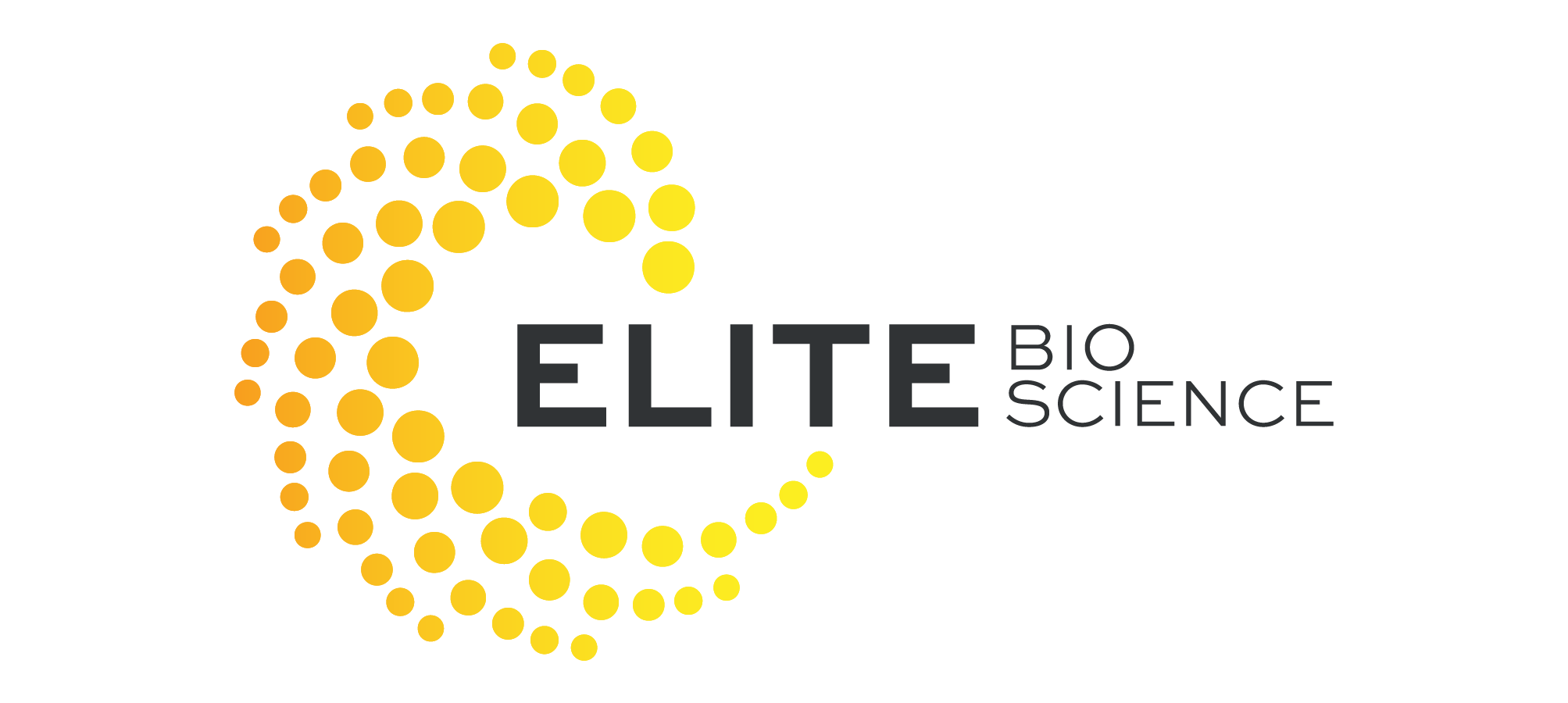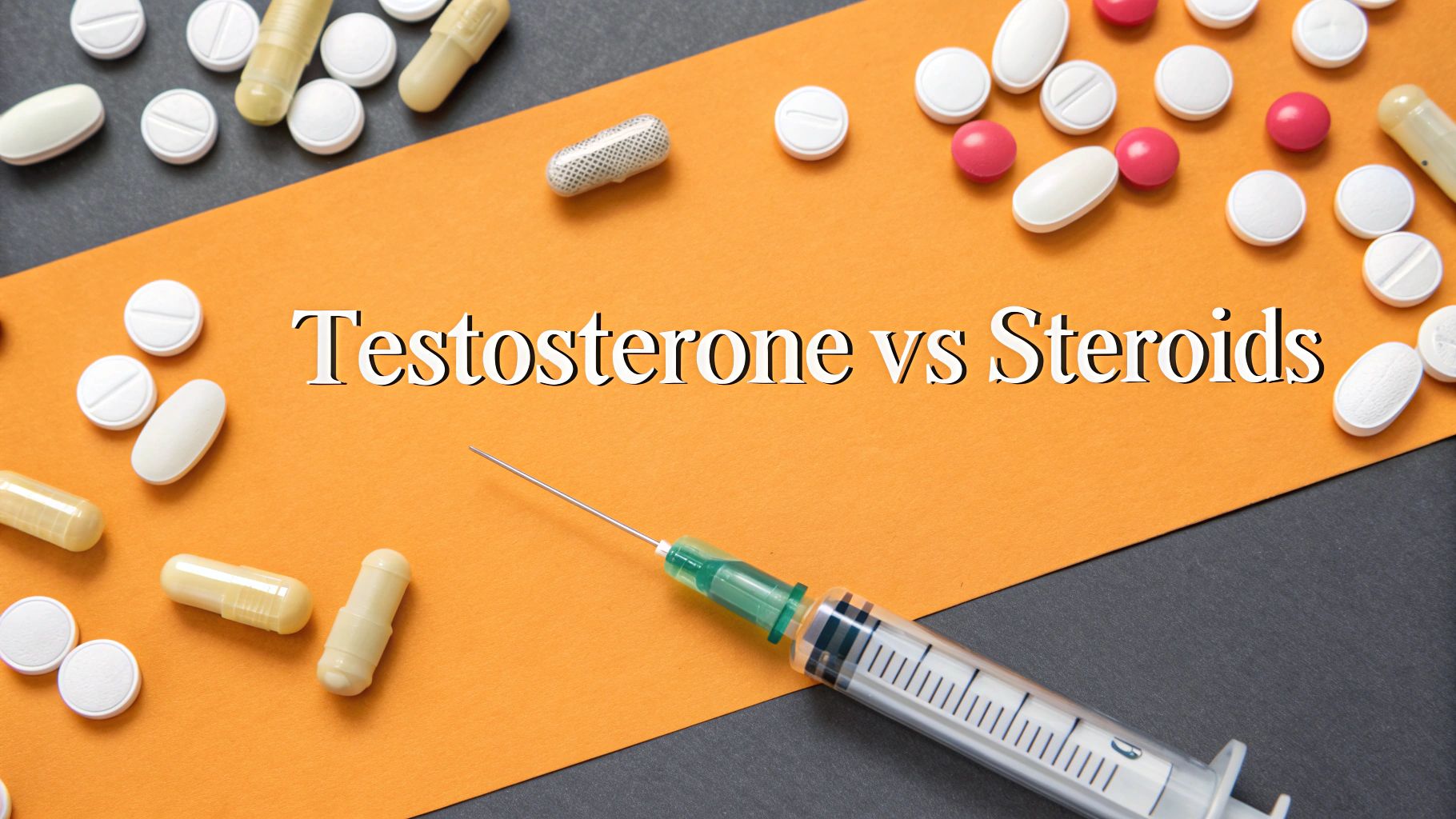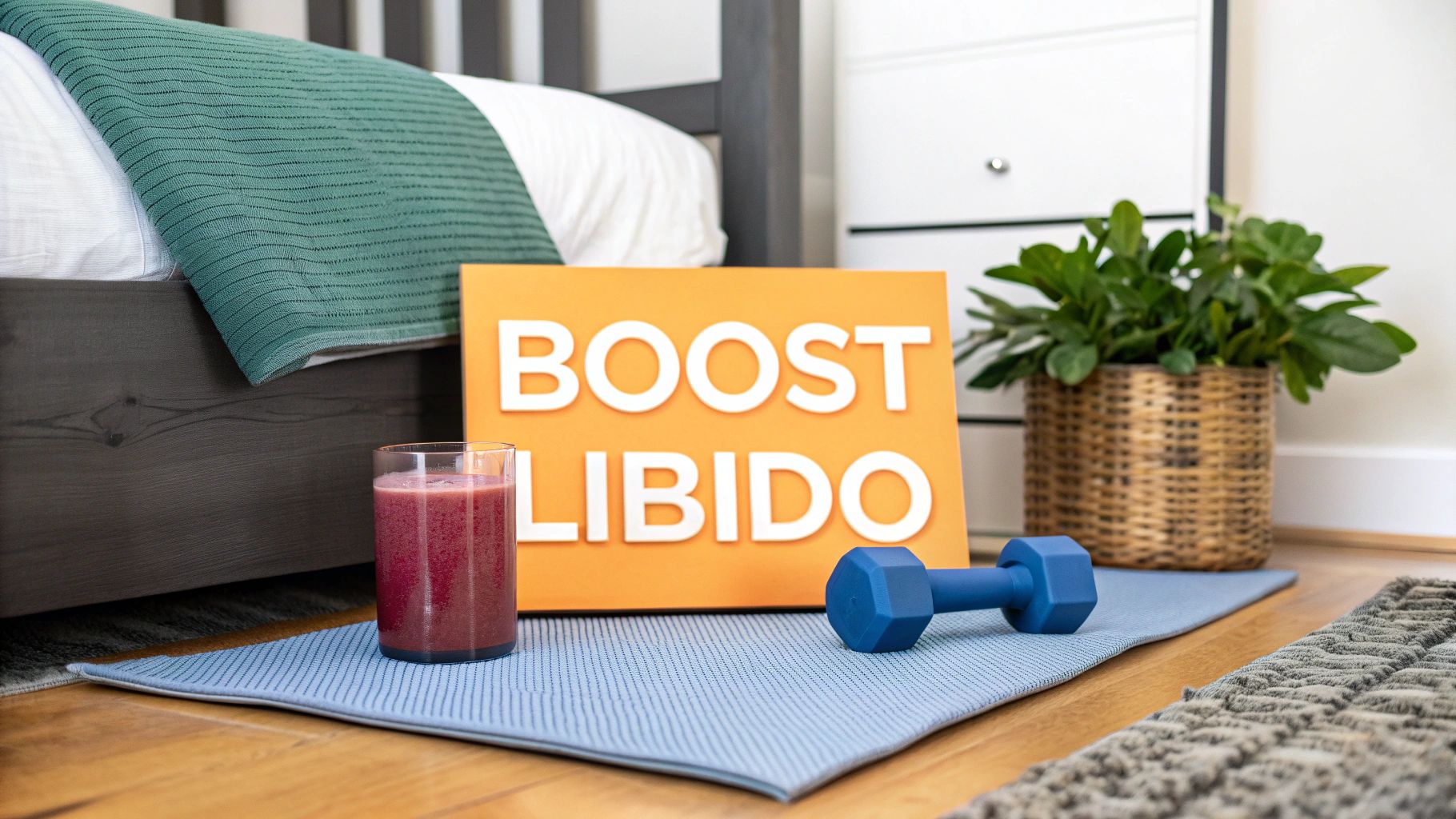Peptide Therapy for Muscle Growth A Complete Guide

When you hear about peptide therapy for muscle growth, it’s easy to think it’s about adding some foreign substance to your body. But that’s not really how it works. Instead, it uses specific chains of amino acids to signal your body to ramp up its own natural production of growth hormone.
The real goal here is to amplify your body's innate ability to repair and build tissue. It’s like turning up the volume on the internal signals that tell your muscles to grow stronger after a tough workout.
How Peptide Therapy Actually Builds Muscle

To really get how peptide therapy helps you build lean mass, let's use an analogy. Imagine your body is a massive construction project. Your muscles are the buildings going up, and the amino acids from your diet are the raw materials—the steel beams and concrete. But without a foreman to direct the work, those materials just sit in a pile.
This is exactly where peptides come in. Think of them as the project foremen on the job site. They aren't lifting the steel themselves; instead, they carry specific instructions to the work crews—your cells—telling them what to build, how fast to work, and when to get started.
The Key Hormonal Response
The main "work order" these peptide foremen deliver goes straight to your pituitary gland, the master control center for your body's hormones. They instruct it to increase both the production and release of Human Growth Hormone (GH). This is the crucial first step.
Once GH levels are elevated, it signals your liver to produce another incredibly powerful growth factor: Insulin-Like Growth Factor 1 (IGF-1).
This GH-to-IGF-1 pathway is the real engine of muscle growth. It’s responsible for:
- Accelerating Protein Synthesis: It ramps up the speed at which your cells use amino acids to build new muscle tissue, which is especially important after resistance training.
- Improving Muscle Repair: It helps mend the micro-tears in muscle fibers that happen during exercise—a process that’s absolutely essential for gains in size and strength.
- Boosting Cell Regeneration: It encourages the development of new muscle cells, which leads to greater muscle density and size over time.
Peptide therapy doesn't invent some new, unnatural way to build muscle. It simply makes your body’s existing muscle-building processes far more efficient and powerful.
Key Takeaway: Peptide therapy supercharges your body's natural anabolic systems. By triggering a greater release of GH and IGF-1, it creates the perfect internal environment for muscle repair, recovery, and growth, allowing you to get much more out of your training and nutrition.
To give you a quick reference, this table breaks down the most common peptides used for muscle growth, what they do, and their main benefits.
Key Peptides and Their Functions in Muscle Growth
| Peptide | Type | Primary Function | Key Benefit |
|---|---|---|---|
| CJC-1295 | GHRH | Stimulates a slow, steady release of GH | Sustained elevation of GH and IGF-1 levels for long-term growth. |
| Ipamorelin | GHRP | Triggers a precise pulse of GH release without affecting other hormones | Targeted muscle growth with minimal side effects like hunger or cortisol spikes. |
| Sermorelin | GHRH | Mimics the body's natural GH-releasing patterns | Promotes lean muscle mass and fat loss by restoring youthful GH levels. |
| Tesamorelin | GHRH | Specifically targets visceral fat while increasing IGF-1 | Excellent for body recomposition, reducing stubborn belly fat while building muscle. |
This table shows how different peptides offer unique ways to optimize your body's muscle-building machinery, allowing for a more tailored approach to your fitness goals.
A Powerful Biological Amplifier
Certain peptides have a remarkable ability to amplify this natural process. The two main classes used for this are Growth Hormone Releasing Hormones (GHRHs) and Growth Hormone Releasing Peptides (GHRPs).
For instance, CJC-1295, a GHRH, has been shown in studies to increase GH levels by 2 to 10 times over baseline for up to six days. Even better, it keeps IGF-1 levels elevated at 1.5 to 3 times the normal baseline for nearly two weeks, providing a long-lasting signal for your body to grow and repair.
This sustained elevation is what makes peptide therapy for muscle growth so effective. It’s not about a single, short spike but rather a prolonged state of enhanced anabolic activity.
While the biology is complex, the outcome is straightforward—it helps you build lean mass more effectively than you could on your own. The full range of advantages extends far beyond just muscle, and you can explore more about the wide-ranging peptide therapy benefits in our detailed guide. By optimizing your body’s own powerful hormonal systems, you unlock greater potential for achieving your fitness goals.
Choosing The Right Peptides For Lean Mass

Stepping into the world of peptide therapy can feel a lot like walking into a supplement store for the first time. You're faced with dozens of options, all promising similar results. But just like protein powders, the real magic is in the details—how they work, what they’re made of, and when to use them.
Choosing the right peptides isn’t about finding one “magic bullet.” It’s about understanding how different peptides can work as a team to help you reach your goals. Some are built to directly promote growth, while others are masters of recovery, laying the groundwork for consistent, hard training. The most powerful strategies almost always involve stacking peptides that complement each other, creating a combined effect that’s far greater than what any single compound could deliver on its own.
The Powerhouse Duo: CJC-1295 And Ipamorelin
When the goal is building lean, solid muscle, the combination of CJC-1295 and Ipamorelin is pretty much the gold standard. This stack is famous for its ability to create powerful yet clean muscle-building signals. Think of them as two expert coaches working in tandem to get the absolute best performance from their team.
CJC-1295 is a Growth Hormone Releasing Hormone (GHRH). Its job is to give your pituitary gland a steady, long-lasting signal to produce more growth hormone. It creates a slow, consistent "bleed" of GH that elevates your baseline levels all day, putting your body in a constant anabolic state.
Ipamorelin, on the other hand, is a Growth Hormone Releasing Peptide (GHRP). It delivers a sharp, strong "pulse" of GH. What makes Ipamorelin so valuable is its precision. It triggers GH release without messing with other hormones like cortisol (the stress hormone that breaks down muscle) or prolactin, which can get in the way of your progress.
Synergistic Action: When you combine them, CJC-1295 raises the overall tide of growth hormone, and Ipamorelin creates a powerful high tide right on top of it. This dual-action attack results in a much bigger GH release and, in turn, higher levels of IGF-1, kicking muscle protein synthesis into overdrive.
This synergy is why the combo has become a go-to in many personalized medical programs. These peptides act like precise text messages to your cells, telling them to ramp up growth hormone, fix tissues, and keep inflammation in check. It's this targeted approach that has made compounds like CJC-1295 and Ipamorelin a favorite tool for dedicated athletes and fitness enthusiasts around the world.
The Essential Recovery Agents: BPC-157 And TB-500
While growth hormone secretagogues are busy signaling for new muscle, another class of peptides is playing an equally important role behind the scenes. These are the recovery agents—the unsung heroes of any serious training program. After all, you can't train hard and consistently if you're always dealing with nagging injuries or crippling soreness.
Peptides like BPC-157 and TB-500 are the superstars of this domain. They don’t trigger huge growth hormone pulses, but they supercharge your body’s natural healing processes right down to the cellular level.
-
BPC-157 (Body Protection Compound-157): This peptide is a master of tissue repair. It works by promoting angiogenesis—the creation of new blood vessels—which rushes oxygen and nutrients straight to damaged tissues. It’s particularly effective for nagging injuries in muscles, tendons, and ligaments.
-
TB-500 (Thymosin Beta-4): Think of this one as a systemic healing agent. It works throughout the body to reduce inflammation, call cells to injury sites, and support the regeneration of all kinds of tissues. This makes it fantastic for overall recovery and dialing down the systemic stress that comes from brutal workouts.
Pairing these recovery peptides with a growth stack like CJC-1295 and Ipamorelin creates a truly comprehensive strategy. The GH peptides are telling your body to build, while the recovery peptides are making sure your underlying structures—tendons, ligaments, and muscle fibers—are strong enough to handle the demand. This approach cuts down on downtime and allows you to train harder and more often, which is the real key to making progress.
If you want to dig deeper into which compounds might be the best fit for your specific goals, check out our complete guide on the best peptides for muscle growth. This kind of holistic approach ensures you're not just building muscle for today, but also protecting your body for long-term athletic health.
Mastering Peptide Dosing and Administration
Moving from knowing what peptides do to actually using them is where the theory hits reality. This is the part that can feel a bit intimidating, but honestly, with the right guidance, mastering peptide dosing and administration is both straightforward and safe. It’s less about complicated medical procedures and more about being precise, consistent, and in tune with your body.
The journey doesn't start with a syringe, but with a solid strategy you develop alongside a healthcare professional. This plan will map out your specific dose, how often you’ll take it, and for how long. Think of it as a custom-tailored training program—it's designed for your body and your goals, not anyone else's.
Loading Doses vs. Maintenance Doses
When you begin peptide therapy for muscle growth, your protocol will usually have two clear phases: a loading phase and a maintenance phase. Each one has a distinct and equally important job.
The loading phase is all about getting a jump-start on your results. It involves a higher dose or more frequent administration for a short time to quickly saturate your system and get your pituitary gland responding. It’s a bit like flooring the gas pedal to get a car up to highway speed—you do it to build momentum fast.
After that initial push comes the maintenance phase. Here, the dosage is usually lowered to a level that sustains the elevated GH and IGF-1 levels you've already achieved. This is your "cruise control" setting, designed for steady, long-term gains without pushing your system too hard.
Key Insight: The goal isn't to slam your body with the highest dose possible, but to find the optimal dose. More is definitely not better here, and can lead to diminishing returns or a higher chance of side effects. Starting low and adjusting based on how you feel is always the smartest and safest way to go.
The biological process these doses kick off can be boiled down to three core steps. This infographic shows the basic domino effect from the moment a peptide enters your body to the final result of muscle growth.

As you can see, it's a direct chain reaction. The peptide is just the first domino, triggering a cascade of biological events that lead to more muscle.
The Importance of Cycling
Just like you schedule rest days from the gym to let your muscles recover and grow, your body needs scheduled breaks from peptide therapy. This is called cycling, and it's a non-negotiable part of any intelligent protocol.
Cycling simply means taking strategic breaks from your regimen. A common approach might be 5 days on and 2 days off each week, or a longer cycle like 3 months on followed by 1 month off. This prevents your pituitary gland from getting "numb" to the peptides' signals, ensuring they stay effective for the long haul.
A Step-By-Step Guide to Administration
Most peptides for muscle growth are delivered via subcutaneous injection, which just means it goes right under the skin. The method is simple, surprisingly painless, and incredibly effective at getting the peptide into your system.
Here’s a clear breakdown of how it works:
-
Reconstitution: Peptides almost always come as a lyophilized (freeze-dried) powder. You'll mix this with a sterile liquid, usually bacteriostatic water, which keeps bacteria from growing in the vial. Your provider will give you exact measurements for this.
-
Drawing the Dose: Using a tiny insulin syringe, you'll carefully draw up your prescribed dose from the vial. Precision matters, so take a moment to double-check the measurement lines on the syringe.
-
Injection: The injection itself is quick and easy. You’ll gently pinch an area of skin—the abdomen is a popular spot—and insert the very fine needle at about a 45-degree angle. Most people report feeling little to nothing at all.
-
Proper Storage: Once you've mixed your peptide, it absolutely must be stored in the refrigerator to protect its potency. These are delicate molecules, so you should never shake the vial or let it get too hot or cold.
While the process is straightforward, getting personalized guidance is essential. Finding a trustworthy provider is crucial, and our guide to navigating peptide therapy online can help you identify reputable sources and qualified medical professionals to ensure your safety and success.
Setting Realistic Expectations for Your Results

Starting a peptide protocol is exciting, but let's ground those expectations in reality. Peptides are powerful biological amplifiers, not overnight magic pills. Think of them as premium fuel for a high-performance engine; the fuel can unlock incredible potential, but the engine’s condition and the driver's skill ultimately determine its performance on the track.
Your body is that engine, and its unique blueprint—shaped by your age, genetics, diet, and training regimen—dictates how you'll respond. Understanding these variables is the key to setting achievable goals and truly appreciating the power of peptide therapy for muscle growth.
Your Personal Blueprint for Success
No two people will ever see the exact same results, simply because everyone's starting point is different. There are a few key factors that create the unique landscape where peptides will do their work.
- Age and Genetics: Your age is one of the biggest factors. A 45-year-old looking to regain lost muscle has a completely different hormonal baseline than a 25-year-old athlete pushing for peak performance. Genetics also play a huge role, determining your natural sensitivity to growth hormone and your baseline predisposition for building muscle.
- Diet and Nutrition: Peptides signal your body to build, but they don't supply the bricks and mortar. A high-protein diet is absolutely non-negotiable. Without enough amino acids, your body simply can’t carry out the "build" orders the peptides are sending.
- Training Consistency: You have to provide the stimulus. Consistent, challenging resistance training is what creates the micro-tears in muscle that peptides help repair and rebuild stronger than before. Without the work, the peptides have nothing to amplify.
- Sleep Quality: This is where the real magic happens. Your body releases the most growth hormone during deep sleep, making 7-9 hours of quality rest non-negotiable for letting the therapy work effectively.
Both real-world and clinical data show just how much these variables influence outcomes. For example, users over 40, who often have naturally lower growth hormone, might see more dramatic gains—sometimes 40-60% better muscle growth results with consistent training—than younger users. To learn more about how different people respond, check out this in-depth guide on the best peptides for muscle growth.
The Typical Timeline for Results
Patience is a virtue, especially with peptide therapy. While some benefits show up quickly, visible muscle changes take time to materialize as your body adapts and builds new tissue.
Key Insight: Progress isn't always linear. You will likely feel the benefits long before you see them. Improved recovery and deeper sleep are often the very first signs that the therapy is working, laying the foundation for the physical changes to come.
Here is a general timeline you can expect:
- Weeks 1-4: The first thing most people notice is enhanced recovery. You might feel less sore after workouts and experience deeper, more restorative sleep. Your energy levels throughout the day may also start to tick upward.
- Months 1-3: This is where you begin to see tangible changes in your body composition. You might notice increased muscle fullness, better definition, and some fat loss. Your strength in the gym should be steadily climbing.
- Months 3-6: Significant, visible muscle growth becomes much more apparent. By this point, the cumulative effects of enhanced protein synthesis and recovery are really paying off. This is often when friends and family start to notice a difference.
Remember, this is a marathon, not a sprint. Your commitment to the fundamentals—training, diet, and sleep—is what unlocks the full potential of peptide therapy.
Of course. Here is the rewritten section, crafted to sound completely human-written and match the expert tone of your example blog posts.
Navigating Potential Risks and Side Effects Safely
Any medical treatment powerful enough to deliver impressive results for muscle growth also comes with potential risks. An honest conversation about safety isn’t meant to scare you off; it’s about giving you the knowledge to make smart, responsible decisions for your health.
The good news is that when peptide therapy is managed by a medical professional using high-quality, pharmacy-grade products, the side effects are typically minor. In fact, many are simply signs that your body is responding to the treatment and ramping up its natural growth and repair processes.
Understanding Common and Manageable Side Effects
For most people, the side effects of medically supervised peptide therapy are mild and short-lived. Think of them as temporary adjustments while your body finds its new, optimized hormonal balance.
You might experience a few predictable things:
- Injection Site Irritation: This is the most common issue by far. A little redness, itchiness, or minor swelling right at the injection spot is normal and usually disappears within an hour or so.
- Increased Hunger: Some growth hormone-releasing peptides can also stimulate ghrelin, the "hunger hormone." While this can catch you off guard, it’s often a welcome effect for anyone trying to build mass, as it helps you hit your necessary calorie goals.
- Water Retention: You might notice a temporary feeling of fullness or mild bloating, sometimes in your hands and feet. This is a common, short-term effect as your body adjusts to its new hormonal equilibrium.
- Fatigue or Tiredness: Your body is putting more energy toward repair and growth, especially when you sleep. It’s not unusual to feel a bit more tired at first, but this typically fades as you adapt to the enhanced recovery cycles.
Crucial Distinction: These manageable side effects are fundamentally different from the serious dangers that come with unregulated products. Your safety hinges on one thing: ensuring every vial you use is sourced from a licensed, reputable compounding pharmacy.
The Dangers of Unverified Sources
Let's be blunt: the single biggest risk in peptide therapy for muscle growth comes from the black market. Peptides sold online "for research purposes only" are completely unregulated and pose a serious threat to your health.
The gamble you take with these products is massive:
- Contamination: These labs often have non-existent quality control. You could be injecting products tainted with bacteria, heavy metals, or other dangerous substances.
- Incorrect Dosages: What the label says is often not what’s in the vial. You might be injecting a much stronger—or weaker—dose than you realize, leading to either ineffective results or dangerous side effects.
- Wrong Substance: In the worst-case scenario, the vial might not even contain the peptide you ordered. You could be injecting an entirely different and potentially harmful compound.
This is a risk that is never worth taking. Period. Sourcing your peptides through a verified medical provider like Elite Bioscience is the only way to guarantee you’re getting a pure, accurately dosed, and sterile product. Working with a knowledgeable professional who monitors your progress and adjusts your protocol is how you pursue your goals safely and effectively, minimizing every possible risk along the way.
Frequently Asked Questions About Peptides
As you start looking into peptide therapy for muscle growth, it’s completely normal to have questions. Getting a handle on the practical side of things—like legality, cost, and how it fits with your current fitness plan—is every bit as important as understanding the science. Here, we tackle the most common questions with straightforward, clear answers to help you feel confident moving forward.
Is Peptide Therapy Legal and Safe?
Navigating the legality of peptides can feel confusing, but the difference between safe and risky is actually pretty simple. You’ll often see peptides online labeled “for research purposes only.” These products are completely unregulated, operate in a legal gray area, and are definitely not meant for people to use. Buying from these sources is a huge gamble—you have no idea what’s really in the vial, if the dose is right, or if it’s even pure.
The only legitimate and safe route is through a medical provider. When a doctor prescribes peptide therapy, the peptides come from a licensed compounding pharmacy. These facilities are regulated and have to meet strict quality control standards, so you know the product you’re getting is sterile, pure, and dosed correctly.
The Bottom Line: Medically supervised peptide therapy, using products from a licensed compounding pharmacy, is legal and the only safe way to go. Anything else is an unnecessary risk to your health and wallet.
Can Women Benefit From Peptide Therapy?
Absolutely. While it’s often talked about in men’s health, peptide therapy is an amazing tool for women who want to improve their physique and performance. The goal isn’t always about getting huge; it’s more about building lean, toned muscle, improving body composition, and recovering faster.
For women, peptides can bring a unique set of benefits:
- Enhanced Muscle Tone: Peptides like Ipamorelin can help you develop lean muscle without adding a lot of bulk, leading to a more defined and sculpted look.
- Improved Fat Metabolism: Many peptides that trigger growth hormone also help your body burn stored fat more efficiently, especially in those stubborn areas.
- Faster Recovery: Just like with men, peptides cut down on post-workout soreness and help repair tissue faster, so you can hit the gym more consistently and effectively.
- Support for Skin and Joints: Peptides like BPC-157 don’t just help with muscle repair; they also support collagen production, which is great for skin elasticity and joint health.
The protocols for women might look a little different than for men, often using specific doses tailored to their unique hormonal makeup and fitness goals. The focus is on fine-tuning the body's natural systems to build a strong, lean, and resilient physique.
What Is the Typical Cost Of Peptide Therapy?
The financial investment for peptide therapy can vary quite a bit, so it helps to have a realistic idea of what to expect. There's no single price tag, because the cost really depends on a few key factors.
Think of it like budgeting for a custom meal plan—the final cost is based on the specific ingredients, how much you need, and how long you'll be on it.
Here’s what shapes the overall cost:
- The Specific Peptide(s): More common peptides like BPC-157 might be more affordable than newer or more complex ones like Tesamorelin. If you're stacking multiple peptides, that will also increase the cost.
- Your Required Dosage: A bigger person or someone with more aggressive goals will likely need a higher dosage, which directly affects how quickly you go through a vial.
- Duration of Your Cycle: A typical muscle growth cycle runs for at least three to six months. The longer your protocol, the higher the total investment will be.
- Source of the Peptides: This is the big one. A comprehensive medical program that includes doctor consultations, prescriptions, and pharmacy-grade peptides will cost more than grabbing "research" vials on your own.
While it might be tempting to save a few bucks by buying from unregulated online sources, you’re trading a lower price for a massive health risk. The price of a clinical program includes the peace of mind that comes from medical supervision and guaranteed product quality—an invaluable part of the investment.
Do I Still Need To Train and Diet On Peptides?
This is probably the most important question, and the answer is a firm yes. It’s a huge misconception that peptides are a substitute for hard work. They aren’t a magic pill that lets you skip the gym or eat junk food and still build muscle.
The best way to think about peptide therapy for muscle growth is as a powerful catalyst.
Imagine you're trying to build a roaring fire. Your consistent training is the wood, and your high-protein diet is the kindling. You can definitely get a decent fire going with just those two things. Peptides are the lighter fluid—they don't create the fire on their own, but when you add them to the wood and kindling, they make the flames explode.
Peptides amplify the results of the work you're already putting in. They create the perfect internal environment for growth by boosting protein synthesis and speeding up repair, but they need a stimulus to work on. Without the micro-tears from training and the amino acids from your diet, the peptides have nothing to build or fix. Your dedication in the gym and the kitchen is the true engine of muscle growth; peptides are just the turbocharger that unlocks its full potential.
Ready to unlock your body's full potential safely and effectively? At Elite Bioscience, we provide medically supervised peptide therapies sourced from licensed compounding pharmacies, ensuring purity and potency. Take the first step towards your fitness goals by exploring our tailored programs at https://elitebioscience.co.
QUICK SEARCH
Make an account today to start your journey towards a better and healthier lifestyle.






